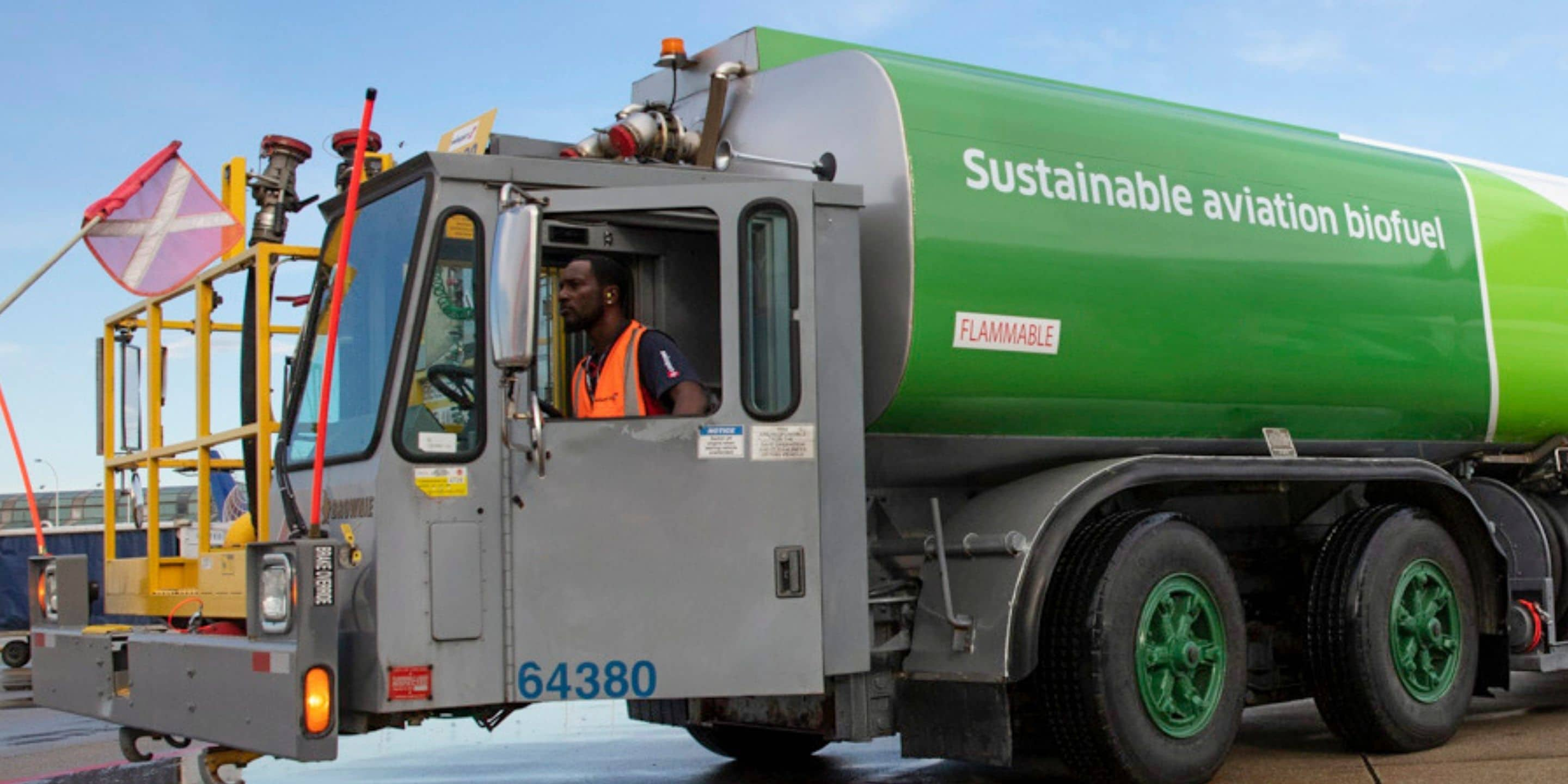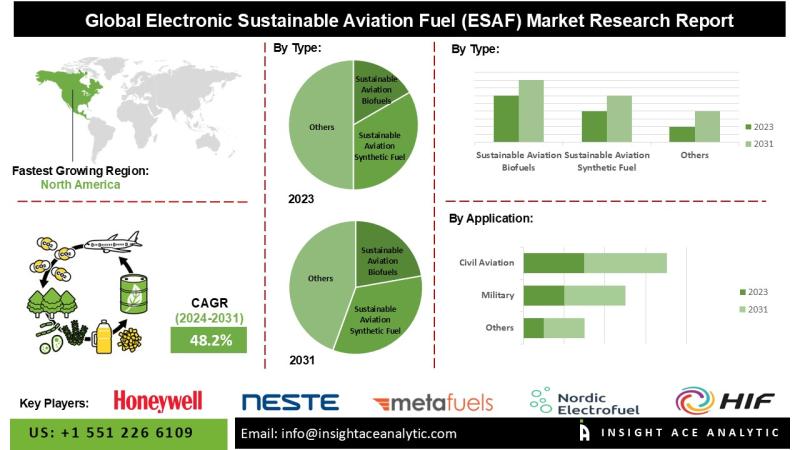
The aviation industry is witnessing a remarkable transformation as Electronic Sustainable Aviation Fuel (ESAF) emerges as a game-changing solution for decarbonization. With a projected compound annual growth rate of 48.2% through 2031, this revolutionary fuel technology is capturing the attention of major airlines, energy companies, and governments worldwide. The market's explosive growth reflects the industry's urgent need for sustainable alternatives that can deliver both environmental benefits and operational efficiency.
>> RELATED: Honeywell Revolutionizes Ethanol-to-jet Fuel Technology to Meet Rising Demand for Sustainable Aviation Fuel

The Science Behind the Revolution
ESAF represents a breakthrough in sustainable fuel production through Power-to-Liquid (PtL) technology. This innovative process harnesses renewable electricity to split water into hydrogen and oxygen through electrolysis, then combines the hydrogen with captured carbon dioxide to create liquid hydrocarbons. The result is a drop-in replacement fuel that requires no modifications to existing aircraft or fuel infrastructure.
Key ESAF Performance Metrics
- 88-90% reduction in greenhouse gas emissions compared to conventional jet fuel
- 3-30x less land use than alternative sustainable fuel options
- 1,000x less water consumption during production process
- Direct substitution capability with existing jet fuel infrastructure
The technology's appeal lies in its ability to produce fuel from abundant resources while delivering significant environmental benefits. Unlike biofuels that compete with food crops for land, ESAF production relies on atmospheric carbon dioxide and renewable energy, creating a truly sustainable fuel cycle.
Industry Giants Drive Market Expansion
The ESAF market features an impressive lineup of industry leaders working to scale production and deployment. Honeywell has emerged as a technology pioneer with its UOP eFining system, while energy giants like TotalEnergies, BP, and Shell are investing heavily in production facilities.

"As demand for SAF continues to grow, the aviation industry is challenged by limited supplies of traditional SAF feedstocks such as vegetable oils, animal fats and waste oils."
Ken West, President and CEO of Honeywell Energy and Sustainability Solutions
Specialized companies are also making significant contributions to the sector. HIF Global and Nordic Electrofuel are developing some of Europe's first industrial-scale PtL facilities, while Infinium and Twelve are advancing next-generation production technologies.
North America Leads the Charge
North America has positioned itself as the global leader in ESAF adoption, driven by favorable government policies and robust regulatory support. The region's aviation industry is aggressively pursuing carbon reduction goals, with major airlines integrating sustainability targets into their core business strategies. Strategic partnerships between fuel producers, airlines, and technology companies are accelerating market development across the continent.
The formation of industry alliances and increasing investor interest has enhanced the financial viability of ESAF projects throughout North America. Government incentives and subsidies are providing crucial support for early-stage deployments, while heightened consumer environmental awareness is creating market demand for cleaner aviation alternatives.
Technological Breakthroughs Accelerate Progress
Recent developments in ESAF production technology are driving down costs and improving efficiency. Honeywell's latest hydrocracking technology breakthrough enables the production of sustainable aviation fuel that delivers an additional 3-5% yield while reducing costs by up to 20%. This advancement represents a significant step toward making this efuel economically competitive with conventional jet fuel.

"The world needs a greater supply of sustainable aviation fuel in order to help decarbonize the aviation sector."
Barry Glickman, Vice President and General Manager of Sustainable Technology Solutions at Honeywell
The technology's scalability is being demonstrated through multiple commercial projects worldwide. Companies are establishing production facilities that can generate significant volumes of ESAF while maintaining the high quality standards required for aviation applications. These facilities are proving that large-scale ESAF production is not only technically feasible but also increasingly cost-effective.

>> In Other News: US Companies Cps Energy, Modern Hydrogen Agree to Work on Clean Power Generation Project
Market Segmentation and Applications
The ESAF market spans two primary fuel types: sustainable aviation biofuels and sustainable aviation synthetic fuels. Both categories serve critical roles in the decarbonization strategy, with synthetic fuels offering particular advantages in terms of feedstock availability and production scalability.
| Application Sector | Market Share | Growth Driver |
|---|---|---|
| Civil Aviation | Dominant | Regulatory compliance & consumer demand |
| Military Aviation | Emerging | Energy security & operational requirements |
Civil aviation remains the primary market driver, with commercial airlines under increasing pressure to meet ambitious carbon reduction targets. Military applications are gaining traction as defense organizations recognize the strategic value of domestically produced, sustainable fuel sources. The dual-use nature of ESAF technology creates opportunities for cross-sector collaboration and shared infrastructure development.
Overcoming Production Challenges
While the ESAF market shows tremendous promise, industry stakeholders are actively addressing production and cost challenges. The high capital requirements for PtL facilities and the need for reliable renewable energy infrastructure represent significant hurdles that companies are working to overcome through technological innovation and strategic partnerships.
Access to renewable electricity remains a critical factor in ESAF production economics. Companies are developing integrated solutions that combine renewable energy generation with fuel production facilities, creating synergies that improve overall project viability. These integrated approaches are expected to drive down production costs and increase supply chain reliability.
The Future Takes Wing
The ESAF market represents a pivotal moment in aviation's sustainability journey, with technology breakthroughs and market dynamics aligning to create unprecedented growth opportunities. As production scales up and costs continue to decline, ESAF is positioned to become a cornerstone of the aviation industry's decarbonization strategy. The convergence of regulatory support, technological advancement, and market demand creates a compelling case for continued investment and development in this transformative fuel technology.
With major industry players committing resources and governments providing policy support, the stage is set for ESAF to fundamentally reshape how the world thinks about sustainable aviation. The next decade will likely see this revolutionary fuel technology transition from niche applications to mainstream adoption, marking a new chapter in clean aviation history.
Subscribe to the newsletter
Daily decarbonization data and news delivered to your inbox
Follow the money flow of climate, technology, and energy investments to uncover new opportunities and jobs.
Companies
Latest issues
-
The Three-Continent Move That Redefines SAF
Wishing everyone a restful holiday season.🎄🎅🎁 Inside this Issue ✈️ Cathay Goes Global With SAF in Three-Continent Fuel Deal 🧪 Proton Ventures Partners With Barents Blue For Realization Of The Bar...
-
Can One Truck Fix Hydrogen’s Biggest Problem?
Inside This Issue 🚛 Alberta's Shared Truck Model Could Crack Hydrogen Adoption ✈️ ZeroAvia Completes Financing Round 🌾 Frontier And NULIFE Scale New Biowaste Carbon Removal Approach 🔥 WAGABOX® Of ...
-
North America’s Carbon Removal Year in Review: Winners, Losers, Surprises
Inside This Issue 🌎 North America's Carbon Removal Year in Review: The Deals, Policies, and Milestones That Shaped 2025 🚢 Hapag-Lloyd And North Sea Container Line Win ZEMBA Second E-Fuel Tender 🪨 ...
Company Announcements
-
ClimeFi Announces New 85,000 Tonne Procurement Round
In its latest procurement round, ClimeFi has enabled more than US$18m in durable carbon removal purchases across eight removal pathways: Biochar, Bioenergy with Carbon Capture and Storage (BECCS), ...
-
Vallourec, a world leader in premium seamless tubular solutions, and Geostock, a global specialist in underground storage of energy, have signed a Memorandum of Understanding (MoU) to strengthen th...
-
CMA CGM, DHL Step Up Ocean Freight Decarbonization with Biofuel Deal
DHL Global Forwarding and shipping group CMA CGM have agreed to jointly use 8,990 metric tons of second-generation biofuel to reduce emissions from ocean freight. The initiative is expected to cut...
-
Next-Generation Gas Turbine Control System For Thermal Power Plants Completes Functional Testing
Integration of Mitsubishi Power's control technology with Mitsubishi Electric's high-speed data processing technology Supports rapid load adjustments and diverse fuels including hydrogen Tokyo, ...